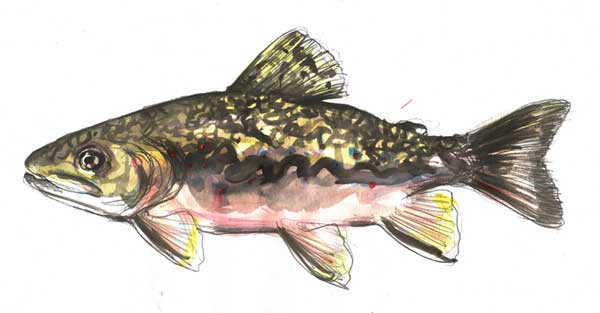
Brook Trout (Salvelinus fontinalis)
Current record: 8lb 3oz
Water: Fontburn reservoir
The brook trout (Salvelinus fontinalis) is a visually stunning freshwater fish native to North America, particularly in the eastern United States and parts of Canada. Renowned for its vibrant colors and distinctive markings, the brook trout is a popular target for anglers seeking both the challenge of its elusive nature and the beauty of its appearance. This species is often associated with clear, cold streams and rivers, where it thrives in well-oxygenated waters.
Characterized by its olive-green to brownish coloration with a marbled pattern and vibrant red spots with blue halos on its sides, the brook trout is easily recognizable. Its lower fins also feature a white leading edge, adding to its overall striking appearance. These colors intensify during the spawning season, making the brook trout even more visually captivating.
Brook trout are opportunistic feeders, consuming a varied diet that includes aquatic insects, small fish, and even terrestrial insects that fall into the water. Their ability to adapt to different food sources contributes to their widespread distribution in diverse aquatic environments, ranging from small mountain streams to larger rivers and lakes. Anglers often employ a variety of lures and baits to entice brook trout, and fly fishing for these fish is particularly popular.
Despite their popularity among anglers, brook trout face several conservation challenges, including habitat degradation, competition with non-native species, and climate change. Efforts to conserve brook trout populations include habitat restoration projects, stocking programs, and the establishment of protected areas where fishing regulations aim to ensure sustainable populations.
Appreciation for the brook trout extends beyond the angling community, as this species symbolizes the health of freshwater ecosystems. Its presence indicates clean, cold water and a balanced aquatic environment. Conservation initiatives aimed at preserving brook trout contribute not only to the well-being of this charismatic fish but also to the overall health of the ecosystems it inhabits.
The brook trout has a dark green to brown colour, with a characteristic marbled pattern of lighter colours across the flanks and back that extends at least to the dorsal fin and frequently to the tail (called vermiculation). Along the flanks, there is a characteristic scattering of red dots encircled by blue haloes. Reddish in colour, the lower fins have white leading edges and a reddish belly. When the fish are spawning, the belly frequently turns bright red or orange, especially on the males.
Large and small lakes, rivers, streams, creeks, and spring ponds are all home to brook trout. They favour highly pure, clear water with a restricted pH range, and they are sensitive to low oxygen levels, pollution, and pH shifts brought on by external factors like acid rain.